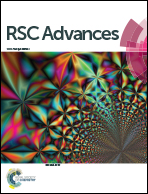Blend membranes of quaternized poly(vinylbenzyl chloride-co-styrene) and quaternized polysulfone for anion-exchange membrane fuel cells†
Abstract
In this study, a poly(vinylbenzyl chloride-co-styrene) (P(VBC-co-St)) copolymer is synthesized through emulsion copolymerization of vinylbenzyl chloride and styrene. The copolymerization process is optimized via orthogonal experiments of seven factors and three levels. The optimized P(VBC-co-St) and chloromethylated polysulfone (CMPSF) are blended in dimethylacetamide to prepare blend anion-exchange membranes (AEM) by solution casting, followed by quaternization and alkalization. The copolymerization and quaternization reactions are confirmed by using Fourier transform infrared attenuated total reflection and 1H nuclear magnetic resonance spectroscopy. X-ray diffraction and scanning electron microscopy are employed to characterize the morphology of AEMs. The properties of AEMs including water uptake, mechanical property and ionic conductivity are investigated. The blend AEM consisting of 60% P(VBC-co-St) and 40% CMPSF is transparent, tough and flexible, showing a water uptake of 34.09 ± 0.68% and an ionic conductivity of 1.84 × 10−2 S cm−1 at 60 °C, a tensile strength of around 15.68 ± 1.62 MPa and a moderate elongation rate at break of about 32.67 ± 1.28%. Moreover, at least 90% of the original ionic conductivity can be kept after it is treated in 1 M NaOH solution for 120 h at 50 °C.


 Please wait while we load your content...
Please wait while we load your content...